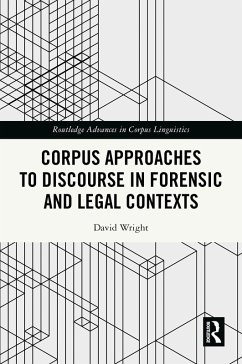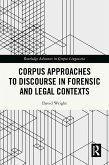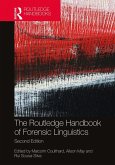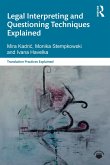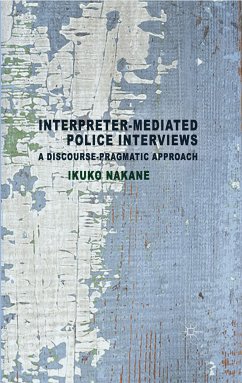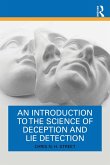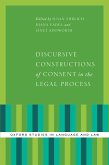David Wright
Corpus Approaches to Discourse in Forensic and Legal Contexts (eBook, PDF)
42,95 €
42,95 €
inkl. MwSt.
Sofort per Download lieferbar

21 °P sammeln
42,95 €
Als Download kaufen

42,95 €
inkl. MwSt.
Sofort per Download lieferbar

21 °P sammeln
Jetzt verschenken
Alle Infos zum eBook verschenken
42,95 €
inkl. MwSt.
Sofort per Download lieferbar
Alle Infos zum eBook verschenken

21 °P sammeln
David Wright
Corpus Approaches to Discourse in Forensic and Legal Contexts (eBook, PDF)
- Format: PDF
- Merkliste
- Auf die Merkliste
- Bewerten Bewerten
- Teilen
- Produkt teilen
- Produkterinnerung
- Produkterinnerung

Bitte loggen Sie sich zunächst in Ihr Kundenkonto ein oder registrieren Sie sich bei
bücher.de, um das eBook-Abo tolino select nutzen zu können.
Hier können Sie sich einloggen
Hier können Sie sich einloggen
Sie sind bereits eingeloggt. Klicken Sie auf 2. tolino select Abo, um fortzufahren.

Bitte loggen Sie sich zunächst in Ihr Kundenkonto ein oder registrieren Sie sich bei bücher.de, um das eBook-Abo tolino select nutzen zu können.
This book is the first of its kind to bridge the gap between corpus linguistics and forensic linguistics, illustrating the value of applying corpus linguistic data, tools, and methods in the analysis of language in the law, evidence, crime, and justice.
- Geräte: PC
- mit Kopierschutz
- eBook Hilfe
- Größe: 3.49MB
Andere Kunden interessierten sich auch für
![Corpus Approaches to Discourse in Forensic and Legal Contexts (eBook, ePUB) Corpus Approaches to Discourse in Forensic and Legal Contexts (eBook, ePUB)]() David WrightCorpus Approaches to Discourse in Forensic and Legal Contexts (eBook, ePUB)41,95 €
David WrightCorpus Approaches to Discourse in Forensic and Legal Contexts (eBook, ePUB)41,95 €![The Routledge Handbook of Forensic Linguistics (eBook, PDF) The Routledge Handbook of Forensic Linguistics (eBook, PDF)]() The Routledge Handbook of Forensic Linguistics (eBook, PDF)47,95 €
The Routledge Handbook of Forensic Linguistics (eBook, PDF)47,95 €![Legal Interpreting and Questioning Techniques Explained (eBook, PDF) Legal Interpreting and Questioning Techniques Explained (eBook, PDF)]() Mira KadricLegal Interpreting and Questioning Techniques Explained (eBook, PDF)41,95 €
Mira KadricLegal Interpreting and Questioning Techniques Explained (eBook, PDF)41,95 €![Interpreter-mediated Police Interviews (eBook, PDF) Interpreter-mediated Police Interviews (eBook, PDF)]() I. NakaneInterpreter-mediated Police Interviews (eBook, PDF)73,95 €
I. NakaneInterpreter-mediated Police Interviews (eBook, PDF)73,95 €![An Introduction to the Science of Deception and Lie Detection (eBook, PDF) An Introduction to the Science of Deception and Lie Detection (eBook, PDF)]() Chris N. H. StreetAn Introduction to the Science of Deception and Lie Detection (eBook, PDF)37,95 €
Chris N. H. StreetAn Introduction to the Science of Deception and Lie Detection (eBook, PDF)37,95 €![Gender, Discourse and Ideology in Italian (eBook, PDF) Gender, Discourse and Ideology in Italian (eBook, PDF)]() Federica FormatoGender, Discourse and Ideology in Italian (eBook, PDF)81,95 €
Federica FormatoGender, Discourse and Ideology in Italian (eBook, PDF)81,95 €![Discursive Constructions of Consent in the Legal Process (eBook, PDF) Discursive Constructions of Consent in the Legal Process (eBook, PDF)]() Discursive Constructions of Consent in the Legal Process (eBook, PDF)56,95 €
Discursive Constructions of Consent in the Legal Process (eBook, PDF)56,95 €-
-
-
This book is the first of its kind to bridge the gap between corpus linguistics and forensic linguistics, illustrating the value of applying corpus linguistic data, tools, and methods in the analysis of language in the law, evidence, crime, and justice.
Dieser Download kann aus rechtlichen Gründen nur mit Rechnungsadresse in A, B, BG, CY, CZ, D, DK, EW, E, FIN, F, GR, HR, H, IRL, I, LT, L, LR, M, NL, PL, P, R, S, SLO, SK ausgeliefert werden.
Produktdetails
- Produktdetails
- Verlag: Taylor & Francis eBooks
- Seitenzahl: 268
- Erscheinungstermin: 20. Februar 2025
- Englisch
- ISBN-13: 9781040311059
- Artikelnr.: 72735181
- Verlag: Taylor & Francis eBooks
- Seitenzahl: 268
- Erscheinungstermin: 20. Februar 2025
- Englisch
- ISBN-13: 9781040311059
- Artikelnr.: 72735181
- Herstellerkennzeichnung Die Herstellerinformationen sind derzeit nicht verfügbar.
David Wright is an Associate Professor in Linguistics at Nottingham Trent University in the United Kingdom.
Contents
List of Figures
Acknowledgment
1 Introduction
Forensic, legal and corpus linguistics
Aims of this book
Overview of the book
References
2 Tools for the trade: data and methods
Corpora for forensic and legal linguistics
The corpora used in this book
Data scarcity in forensic and legal linguistics
Overcoming data scarcity
Quasi-legal data: The Grenfell Tower Inquiry Opening Statement Corpus
Opportunistic legal data: The Brexit Hearings Corpus
Potentially illicit data on the 'clear' web: The Seduction Forum Corpus
Language about the law: New Laws in the News Corpus
Ethics and distressing data
Corpus-assisted discourse studies
Corpus linguistic tools
Keyword analysis
Collocation analysis
Concordance analysis
References
3 Thirty years of corpora in forensic and legal linguistics
Corpora at the birth of forensic linguistics
The growing status of corpora in forensic and legal linguistics
Corpora and the development of forensic linguistics
New perspectives on familiar genres
Possible solutions to methodological challenges
New avenues for research
References
4 Positioning and responsibility in the Opening Statements of the Grenfell
Tower Inquiry
Introduction
The Grenfell Tower Inquiry Opening Statement Corpus
Opening statements as a prologue to the evidence
The language of opening statements
Positioning and opening statements
A new model for responsibility allocation
Impression management
Pre-emptive allocation
Delineating involvement and responsibility assignment
Positive action
Conclusion
References
5 Stance-taking by advocates and judges in the Brexit Hearings
Introduction
Background to the 'Brexit case'
The Brexit Hearings Corpus
Stance and stance-taking
Stance and corpus linguistics
Stance in the courtroom
I collocates and stance-markers
Modal verbs - I will
Mental verbs - I think
Speaking verbs - I say
Conclusion
References
6 Online discourses of sexual consent and resistance
Content warning
Discourse, consent and 'utmost resistance'
The Pick-Up Artist Community
The language of PUAs
The Seduction Forum Corpus (SFC)
Consent and resistance in the SFC
Discourse prosodies of LMR
Resistance as something to be overcome
Resistance as insincere
Resistance as remarkable
Resistance as temporary
Conclusion
References
7 The reporting of new laws in the British national press
Introduction
Legislation and media influence
The New Laws in the News Corpus
Using corpus techniques to analyse argumentation
Identifying arguments
Reconstructing arguments
Analysis
Prohibition
Permission
Imposition
Toughness
Necessity
Protection
Controversy
Scope
Summary of argument schemes
Conclusion
References
8 Conclusion
References
Index
List of Figures
Acknowledgment
1 Introduction
Forensic, legal and corpus linguistics
Aims of this book
Overview of the book
References
2 Tools for the trade: data and methods
Corpora for forensic and legal linguistics
The corpora used in this book
Data scarcity in forensic and legal linguistics
Overcoming data scarcity
Quasi-legal data: The Grenfell Tower Inquiry Opening Statement Corpus
Opportunistic legal data: The Brexit Hearings Corpus
Potentially illicit data on the 'clear' web: The Seduction Forum Corpus
Language about the law: New Laws in the News Corpus
Ethics and distressing data
Corpus-assisted discourse studies
Corpus linguistic tools
Keyword analysis
Collocation analysis
Concordance analysis
References
3 Thirty years of corpora in forensic and legal linguistics
Corpora at the birth of forensic linguistics
The growing status of corpora in forensic and legal linguistics
Corpora and the development of forensic linguistics
New perspectives on familiar genres
Possible solutions to methodological challenges
New avenues for research
References
4 Positioning and responsibility in the Opening Statements of the Grenfell
Tower Inquiry
Introduction
The Grenfell Tower Inquiry Opening Statement Corpus
Opening statements as a prologue to the evidence
The language of opening statements
Positioning and opening statements
A new model for responsibility allocation
Impression management
Pre-emptive allocation
Delineating involvement and responsibility assignment
Positive action
Conclusion
References
5 Stance-taking by advocates and judges in the Brexit Hearings
Introduction
Background to the 'Brexit case'
The Brexit Hearings Corpus
Stance and stance-taking
Stance and corpus linguistics
Stance in the courtroom
I collocates and stance-markers
Modal verbs - I will
Mental verbs - I think
Speaking verbs - I say
Conclusion
References
6 Online discourses of sexual consent and resistance
Content warning
Discourse, consent and 'utmost resistance'
The Pick-Up Artist Community
The language of PUAs
The Seduction Forum Corpus (SFC)
Consent and resistance in the SFC
Discourse prosodies of LMR
Resistance as something to be overcome
Resistance as insincere
Resistance as remarkable
Resistance as temporary
Conclusion
References
7 The reporting of new laws in the British national press
Introduction
Legislation and media influence
The New Laws in the News Corpus
Using corpus techniques to analyse argumentation
Identifying arguments
Reconstructing arguments
Analysis
Prohibition
Permission
Imposition
Toughness
Necessity
Protection
Controversy
Scope
Summary of argument schemes
Conclusion
References
8 Conclusion
References
Index
Contents
List of Figures
Acknowledgment
1 Introduction
Forensic, legal and corpus linguistics
Aims of this book
Overview of the book
References
2 Tools for the trade: data and methods
Corpora for forensic and legal linguistics
The corpora used in this book
Data scarcity in forensic and legal linguistics
Overcoming data scarcity
Quasi-legal data: The Grenfell Tower Inquiry Opening Statement Corpus
Opportunistic legal data: The Brexit Hearings Corpus
Potentially illicit data on the 'clear' web: The Seduction Forum Corpus
Language about the law: New Laws in the News Corpus
Ethics and distressing data
Corpus-assisted discourse studies
Corpus linguistic tools
Keyword analysis
Collocation analysis
Concordance analysis
References
3 Thirty years of corpora in forensic and legal linguistics
Corpora at the birth of forensic linguistics
The growing status of corpora in forensic and legal linguistics
Corpora and the development of forensic linguistics
New perspectives on familiar genres
Possible solutions to methodological challenges
New avenues for research
References
4 Positioning and responsibility in the Opening Statements of the Grenfell
Tower Inquiry
Introduction
The Grenfell Tower Inquiry Opening Statement Corpus
Opening statements as a prologue to the evidence
The language of opening statements
Positioning and opening statements
A new model for responsibility allocation
Impression management
Pre-emptive allocation
Delineating involvement and responsibility assignment
Positive action
Conclusion
References
5 Stance-taking by advocates and judges in the Brexit Hearings
Introduction
Background to the 'Brexit case'
The Brexit Hearings Corpus
Stance and stance-taking
Stance and corpus linguistics
Stance in the courtroom
I collocates and stance-markers
Modal verbs - I will
Mental verbs - I think
Speaking verbs - I say
Conclusion
References
6 Online discourses of sexual consent and resistance
Content warning
Discourse, consent and 'utmost resistance'
The Pick-Up Artist Community
The language of PUAs
The Seduction Forum Corpus (SFC)
Consent and resistance in the SFC
Discourse prosodies of LMR
Resistance as something to be overcome
Resistance as insincere
Resistance as remarkable
Resistance as temporary
Conclusion
References
7 The reporting of new laws in the British national press
Introduction
Legislation and media influence
The New Laws in the News Corpus
Using corpus techniques to analyse argumentation
Identifying arguments
Reconstructing arguments
Analysis
Prohibition
Permission
Imposition
Toughness
Necessity
Protection
Controversy
Scope
Summary of argument schemes
Conclusion
References
8 Conclusion
References
Index
List of Figures
Acknowledgment
1 Introduction
Forensic, legal and corpus linguistics
Aims of this book
Overview of the book
References
2 Tools for the trade: data and methods
Corpora for forensic and legal linguistics
The corpora used in this book
Data scarcity in forensic and legal linguistics
Overcoming data scarcity
Quasi-legal data: The Grenfell Tower Inquiry Opening Statement Corpus
Opportunistic legal data: The Brexit Hearings Corpus
Potentially illicit data on the 'clear' web: The Seduction Forum Corpus
Language about the law: New Laws in the News Corpus
Ethics and distressing data
Corpus-assisted discourse studies
Corpus linguistic tools
Keyword analysis
Collocation analysis
Concordance analysis
References
3 Thirty years of corpora in forensic and legal linguistics
Corpora at the birth of forensic linguistics
The growing status of corpora in forensic and legal linguistics
Corpora and the development of forensic linguistics
New perspectives on familiar genres
Possible solutions to methodological challenges
New avenues for research
References
4 Positioning and responsibility in the Opening Statements of the Grenfell
Tower Inquiry
Introduction
The Grenfell Tower Inquiry Opening Statement Corpus
Opening statements as a prologue to the evidence
The language of opening statements
Positioning and opening statements
A new model for responsibility allocation
Impression management
Pre-emptive allocation
Delineating involvement and responsibility assignment
Positive action
Conclusion
References
5 Stance-taking by advocates and judges in the Brexit Hearings
Introduction
Background to the 'Brexit case'
The Brexit Hearings Corpus
Stance and stance-taking
Stance and corpus linguistics
Stance in the courtroom
I collocates and stance-markers
Modal verbs - I will
Mental verbs - I think
Speaking verbs - I say
Conclusion
References
6 Online discourses of sexual consent and resistance
Content warning
Discourse, consent and 'utmost resistance'
The Pick-Up Artist Community
The language of PUAs
The Seduction Forum Corpus (SFC)
Consent and resistance in the SFC
Discourse prosodies of LMR
Resistance as something to be overcome
Resistance as insincere
Resistance as remarkable
Resistance as temporary
Conclusion
References
7 The reporting of new laws in the British national press
Introduction
Legislation and media influence
The New Laws in the News Corpus
Using corpus techniques to analyse argumentation
Identifying arguments
Reconstructing arguments
Analysis
Prohibition
Permission
Imposition
Toughness
Necessity
Protection
Controversy
Scope
Summary of argument schemes
Conclusion
References
8 Conclusion
References
Index
